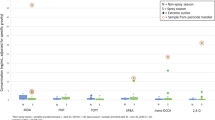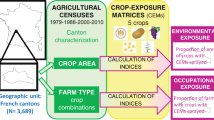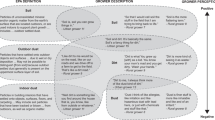Abstract
Exposures to multiple chemical, physical, and biological agents in agricultural work environments can result in confounding that may obscure or distort risks observed in epidemiologic studies. The Agricultural Health Study (AHS) is a large epidemiology study being conducted to investigate health risks among pesticide applicators and their families. During enrollment in the AHS, questionnaires were administered to over 52,000 licensed pesticide applicators from North Carolina and Iowa, who were mostly farmers. Questions about the frequency of various farming tasks were used to estimate the prevalence of exposure to solvents (25%), metals (68%), grain dusts (65%), diesel exhaust fumes (93%), and other hazards, including exposure to pesticides. Most of the farmers in the AHS reported performing routine maintenance tasks at least once a month, such as painting (63%), welding (64%), and repair of pesticide equipment (58%). The majority of farmers (74% in North Carolina; 59% in Iowa) reported holding nonfarm jobs, of which the most frequent were construction and transportation. The majority of the farmers enrolled in the AHS (55%) also reported that they mixed or applied pesticides on 10 or more days per year. The associations between the use of pesticides and the frequency with which the farmers in the AHS reported performing various types of specific farming activities were assessed to evaluate potential confounding. Confounding risk ratios calculated for these activities suggest that the magnitude of bias due to confounding is likely to be minimal.
This is a preview of subscription content, access via your institution
Access options
Subscribe to this journal
Receive 6 print issues and online access
$259.00 per year
only $43.17 per issue
Buy this article
- Purchase on Springer Link
- Instant access to full article PDF
Prices may be subject to local taxes which are calculated during checkout
Similar content being viewed by others
References
Alavanja, M, Sandler, DP, McMaster, SB, Zahm, SH, McDonnell, CJ, Lynch, C, Pennybacker, M, Rothman, N, Dosemeci, M, Bond, AE, Blair, A . The Agricultural Health Study, Environ Health Perspect (1996) 104: 362–369
Blair, A, Zahm, SH, Pearce, NE, Heineman, EF, Fraumeni, JF . Clues to cancer etiology from studies of farmers, Scand J Work Environ Health (1992) 18: 209–215
Blair, A, Stewart, WF, Stewart, PA, Sandler, DP, Axelson, O, Vineis, P, Checkoway, H, Savitz, D, Pearce, N, Rice, C . A philosophy for dealing with hypothesized uncontrolled confounding in epidemiological investigations, Med Lav (1995) 86 2 106–110
Blair, A, Zheng, T, Linos, A, Stewart, PA, Zhang, YW, Cantor, KP . Occupation and leukemia: a population-based case–control study in Iowa and Minnesota, Am J Ind Med (2000) 40: 3–14
Breslow, NE, Day, NE . Statistical Methods in Cancer Research: Vol. 1. The Analysis of Case Control Studies. IARC Scientific Publications, Lyon, France 1980 pp93–108No. 32
Davis, DL, Blair, A, Hoel, DG . Agricultural exposures and cancer trends in developed countries, Environ Health Perspect (1992) 100: 39–44
Nieuwenhuijsen, MJ, Schenker, MB, Saiki, C, Samuels, SJ, Green, SS . Work patterns and self-reported exposure of California farm operators, Appl Occup Environ Hyg (1997) 12 10 685–690
Office of Management and Budget. Standard Industrial Classification Manual. Executive Office of the President, Washington, DC 1987
Petrelli, G, Siepi, G, Miligi, L, Vineis, P . Solvents in pesticides, Scan J Work Environ Health (1993) 19: 63–65
Poppendorf, W, Donham, KJ . Agricultural Hygiene. Chapter 19 in Patty's Industrial Hygiene4th ednWiley, New York 1991 pp575–608
Shaver, CS, Tong, T . Chemical hazards to agricultural workers. Health hazards of farming, Occupational Medicine: State of the Art Reviews. Vol. 6 1991 pp391–413(No. 3)
Tarone, RE, Alavanja, M, Zahm, SH, Lubin, JH, Sandler, DP, McMaster, SB, Rothman, N, Blair, A . The Agricultural Health Study: factors affecting completion and return of self-administered questionnaires in a large prospective cohort study of pesticide applicators, Am J Ind Med (1997) 31: 233–242
US Department of Commerce. Standard Occupational Classification Manual. Office of Federal Statistical Policy and Standards, Washington, DC 1980
Wacholder, S, Rothman, N, Caporaso, N . Population stratification in epidemiologic studies of common genetic variants: quantification of bias, J Natl Cancer Inst (2000) 92 14 1151–1158
Author information
Authors and Affiliations
Corresponding author
Appendix: CRR
Appendix: CRR
The CRR (Table 10) is defined as the ratio of the risk estimate obtained when ignoring confounding divided by the risk estimate obtained after adjustment for confounding. The CRR provides a general measure to estimate the magnitude of bias from a confounding factor (Breslow and Day, 1980). The CRR is calculated from the prevalence of exposure to the confounding factor among subjects who are exposed to the agent of interest (p1), the prevalence of exposure to the confounding factor among subjects who are not exposed to the agent of interest (p2), and the strength of the association between the confounding factor and the disease (ORc). Interestingly, the CRR is not affected by the strength of the association between the exposure and outcome of interest. Given an exposure of interest (E), and a confounding factor (C), the CRR is calculated from Eq. (1):

where:
ORa=odds ratio after stratification by C (adjusted);
ORp=odds ratio ignoring C (crude or pooled);
ORc=odds ratio for confounder C after stratification by exposure E;
p1=prevalence of exposure to C among those exposed to E;
p2=prevalence of exposure to C among those not exposed to E.
Rights and permissions
About this article
Cite this article
COBLE, J., HOPPIN, J., ENGEL, L. et al. Prevalence of exposure to solvents, metals, grain dust, and other hazards among farmers in the Agricultural Health Study. J Expo Sci Environ Epidemiol 12, 418–426 (2002). https://doi.org/10.1038/sj.jea.7500248
Received:
Published:
Issue Date:
DOI: https://doi.org/10.1038/sj.jea.7500248
Keywords
This article is cited by
-
Association of immunotoxicological indices with lung cancer biomarkers in poultry, grape, and rose farming workers
Toxicological Research (2023)
-
The occurrence of bone and joint cancers and their association with rural living and radon exposure in Iowa
Environmental Geochemistry and Health (2023)
-
A principal factor analysis to characterize agricultural exposures among Nebraska veterans
Journal of Exposure Science & Environmental Epidemiology (2017)
-
Factor analysis of pesticide use patterns among pesticide applicators in the Agricultural Health Study
Journal of Exposure Science & Environmental Epidemiology (2005)



